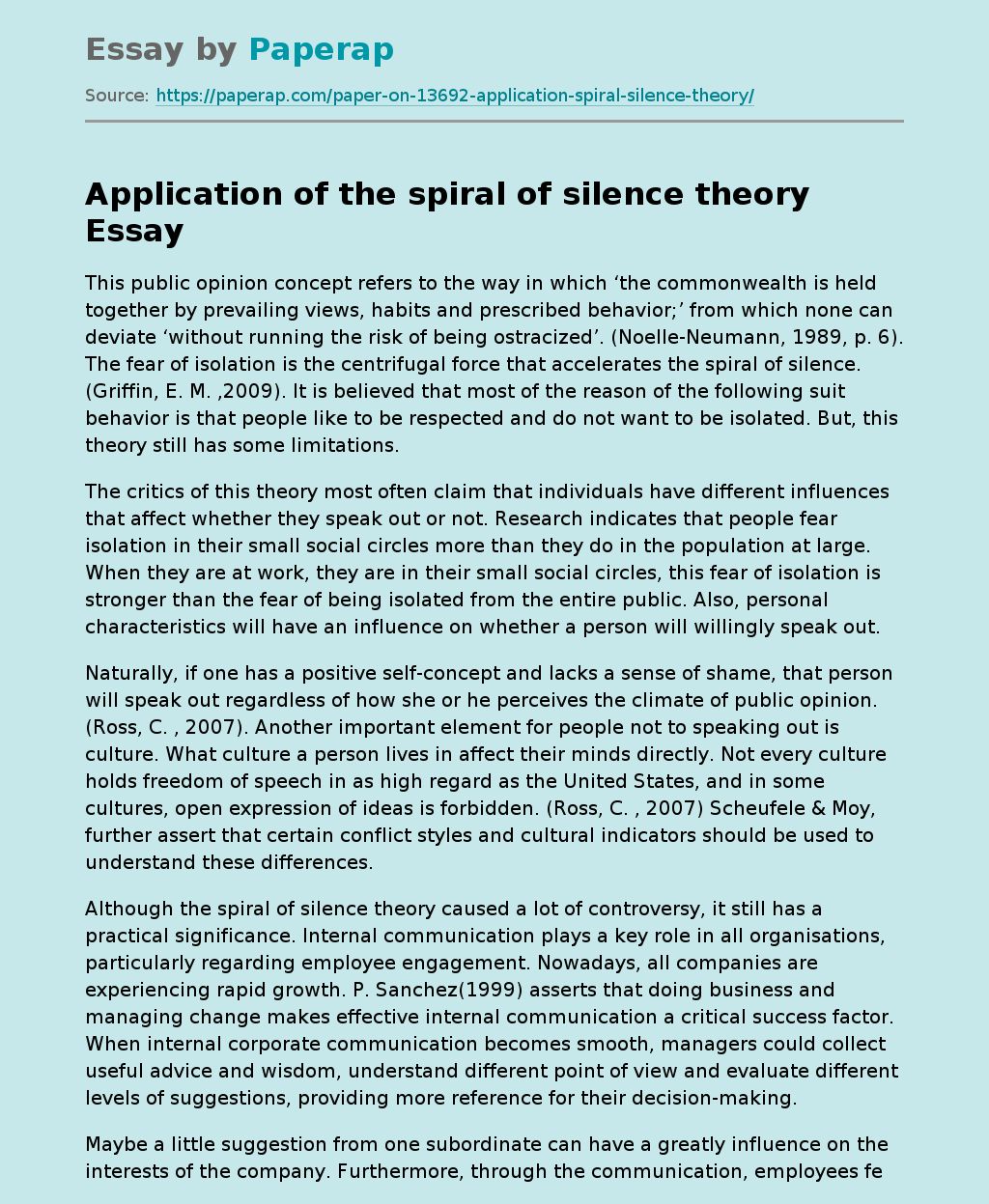Application of the spiral of silence theory
This public opinion concept refers to the way in which ‘the commonwealth is held together by prevailing views, habits and prescribed behavior;’ from which none can deviate ‘without running the risk of being ostracized’. (Noelle-Neumann, 1989, p. 6). The fear of isolation is the centrifugal force that accelerates the spiral of silence. (Griffin, E. M. ,2009). It is believed that most of the reason of the following suit behavior is that people like to be respected and do not want to be isolated. But, this theory still has some limitations.
The critics of this theory most often claim that individuals have different influences that affect whether they speak out or not. Research indicates that people fear isolation in their small social circles more than they do in the population at large. When they are at work, they are in their small social circles, this fear of isolation is stronger than the fear of being isolated from the entire public. Also, personal characteristics will have an influence on whether a person will willingly speak out.
Naturally, if one has a positive self-concept and lacks a sense of shame, that person will speak out regardless of how she or he perceives the climate of public opinion. (Ross, C.
, 2007). Another important element for people not to speaking out is culture. What culture a person lives in affect their minds directly. Not every culture holds freedom of speech in as high regard as the United States, and in some cultures, open expression of ideas is forbidden. (Ross, C. , 2007) Scheufele & Moy, further assert that certain conflict styles and cultural indicators should be used to understand these differences.
Although the spiral of silence theory caused a lot of controversy, it still has a practical significance. Internal communication plays a key role in all organisations, particularly regarding employee engagement. Nowadays, all companies are experiencing rapid growth. P. Sanchez(1999) asserts that doing business and managing change makes effective internal communication a critical success factor. When internal corporate communication becomes smooth, managers could collect useful advice and wisdom, understand different point of view and evaluate different levels of suggestions, providing more reference for their decision-making.
Maybe a little suggestion from one subordinate can have a greatly influence on the interests of the company. Furthermore, through the communication, employees feel comfortable and are respected, it will establish their loyalty and make them care about the development of not only themselves but the whole company. In fact, their engagements directly affect the company’s performance. The theory provides a unique perspective that the final consequence of the discussion in company is not the rational opinions and may be the convergence of the strong opinions.
Sometimes, the strong opinions are not accurate and result in the wrong choice of managers. Because of the spiral of silence, some people hold their opinions in mind and do not speak it out, they will lose their enthusiasms of their work and make no contribution to the company. Usually, those people’s opinions are known as adverse opinion, which are opposite to the leadership or the mainstream. It may be correct, also may be wrong. So we cannot just treat it as wrong opinion. Only if the administrators make it clear, the employees would disclose their true own opinion.
It is not normal that there is not a voice against the majority opinions, this actually means managers do not play a good role in creating a free, democratic environment for employees. As time passes, the staff are too lazy to put forward their opinions. If so, the managers of company will lose so many value aspects of the different voice. Amounts of adverse opinions may stimulate some other new, fresh ideas, sometimes these ideas are even better than the original advantageous opinions . For minorities to stimulate the thinking of the other group members, the minorities have to share their opinions.
Factors that might encourage people to express minority opinions would include having personal qualities that can offset the risk ( Hollander, 1958); getting support for their position ( Latane & Wolf, 1981; Tanford & Penrod, 1984); and having a positive and accepting social atmosphere in the group ( Hackman, 1987). In fact, creating a nonjudgmental atmosphere is the cornerstone of group discussion techniques designed to maximize participant contributions (e. g. , Delbecq, Van de Ven, & Gustafson, 1975; Osborn, 1957).
There is no doubt that the existence of the spiral of silence in company is the last thing managers want to see. If it exists, minority will not comment about many things, they bend to the public opinion. Several different opinions precisely are the indispensable condition of making correct decisions. Critically, that doesn’t mean managers should adopt the minority opinions all the time. When discussing adverse opinions, managers should not reject them flatly, but let employees fully expound them views and reason, and then analysis their opinions seriously.
The reasonable part should be accepted and the unreasonable part should be abandoned. Since some few people’s insights are profound, decision-makers need to determine whether the strategy should be changed. Managers must be able to recognize those wrong opinions, and according to their different properties, adopt appropriate methods. In order to maintain the enthusiasm of staff, it is important for managers to treat all opinions of the staff equally, no matter they are right or wrong, positive or negative and valuable or not valuable.
For those right and valuable opinions, managers should not only verbally accept them, but give the presenters praise and reward. For those abandoned opinions, it is important to encourage the presenters to continue to point their opinions out. Only totally understand how the spiral of silence theory works in the enterprise and treat the disadvantageous opinions properly, administrators could create a smooth channel of internal corporate communication.
Application of the spiral of silence theory. (2018, Jan 30). Retrieved from https://paperap.com/paper-on-13692-application-spiral-silence-theory/

